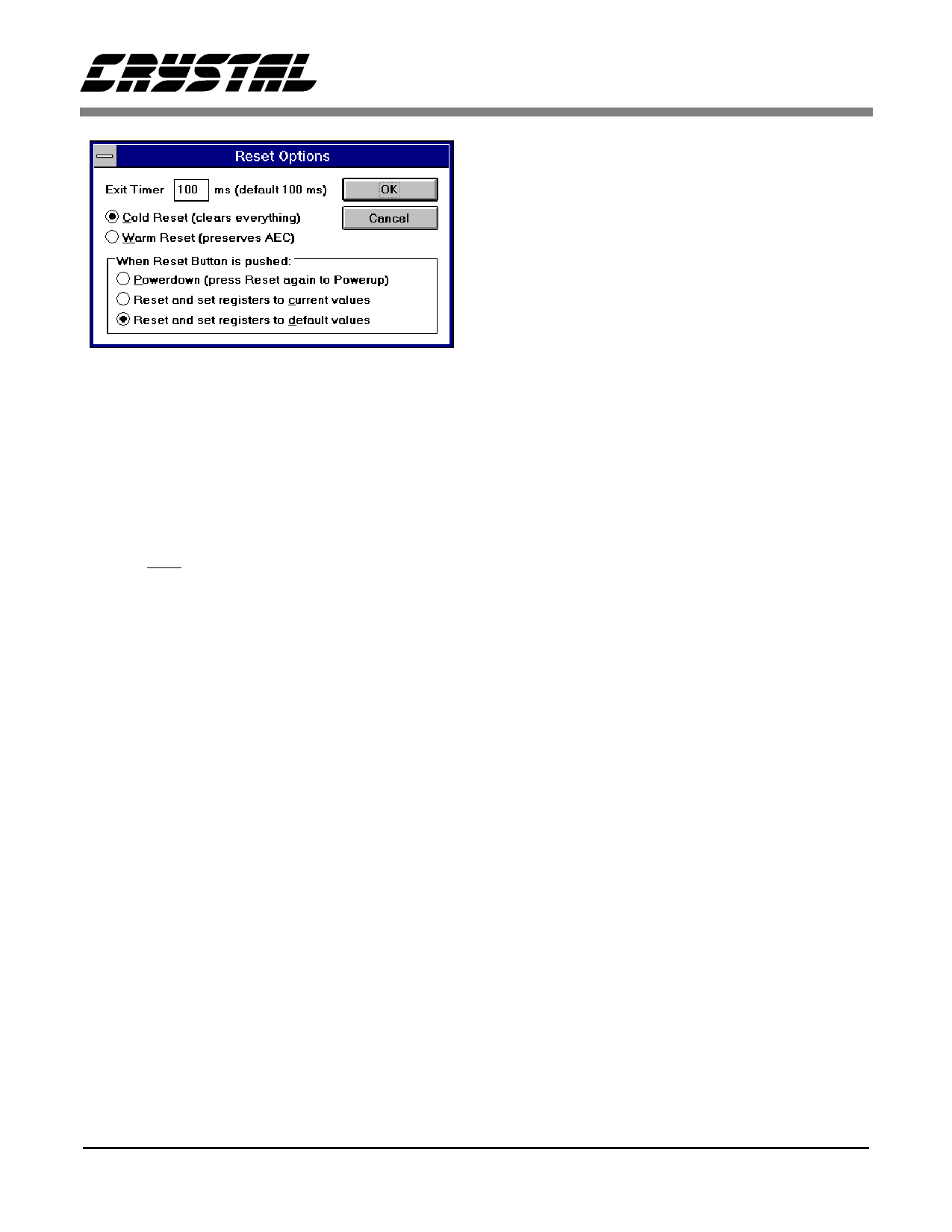CDB6420 Просмотр технического описания (PDF) - Cirrus Logic
Номер в каталоге
Компоненты Описание
Список матч
CDB6420 Datasheet PDF : 52 Pages
| |||

CDB6420
Figure 8. Reset Options
variables to their default values. A warm reset
saves certain key variables to allow the CS6420 to
adapt to the echo path more quickly.
The function of the reset button in the main win-
dow are controlled by the radio buttons in the group
"When Reset Button is pushed:". The first option
will force the CS6420 into a low power mode by
holding RST low until the button is pushed again
(the text on the button will change to reflect this).
The second option will send the current settings of
the four registers to the CS6420 immediately after
performing the reset. The last option will restore
the default values of the registers to the CS6420,
which is the mode selected when the program is
initially started. Note that this option also changes
the register settings in the main window. Also note
that once this type of reset is invoked, the reset type
will automatically be changed to restore current
register values.
Main Window
Figure 9 shows the main window of the CDB6420
Control Program. The main window is a block di-
agram representation of the internals of the CS6420
with all the registers placed in their appropriate lo-
cations in the signal flow. The right side of the
screen is the Near End (or Acoustic Interface), and
the left side is the Far End (or Network Interface.
See figure 9). The upper path is the Receive Path,
and the lower path is the Transmit Path. The hexa-
decimal values of the registers given the current
settings of the controls is given in the lower left
corner. These values are sent to the CS6420 over
the microcontroller interface.
The Controls
There are 27 controls in the CDB6420 Control Pro-
gram main window. These controls map to the four
registers in the CS6420 whose register values can
be seen in hexadecimal format in the lower left of
the main window. The controls can be easily nav-
igated by using the "Tab" key to traverse the con-
trols from left to right, and "Shift-Tab" to reverse
the direction. Furthermore, the four most common-
ly used controls have hotkeys which will take you
to them: RVol (Ctrl+1), TVol (Ctrl+2), NCC
(Ctrl+3), and ACC (Ctrl+4). These are also acces-
sible from the “Control” menu.
Drop-down Box Hints
Once familiar with the values in the drop-down
boxes, one can easily choose specific values by
typing the first letter of the selection, or using the
up and down arrow keys. Typing the first letter of
the selection can help avoid lots of scrolling and
unnecessary writes to the microcontroller interface.
For example, if RVol is currently selected, its value
can be changed to 30 dB by pressing 3 once and to
3 dB by pressing it again. 0 dB is selected by press-
ing 0, and pressing "m" will select mute. Alterna-
tively, if the value is 0 dB, pressing the down arrow
will set the register to -3 dB, and pressing the up ar-
row will set the value to 3 dB.
As another example, when manipulating the
Acoustic Coefficient Controls (ACC) drop-down
box, the desired setting of the three available selec-
tions ("Normal", "Clear", and "Freeze") can be
chosen with the keys "n", "c", and "f". If using the
arrow keys, going to Freeze from Normal would al-
ways result in a Clear, which may not be desired, so
pressing "f" would be preferable. You can always
use the mouse to select the value.
DS205DB1
45